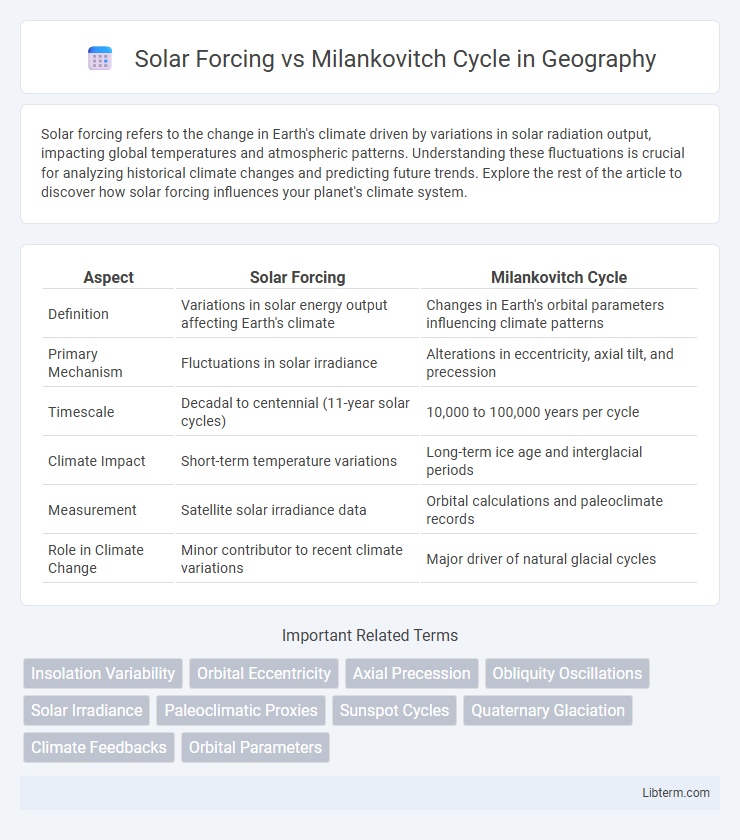Solar forcing refers to the change in Earth's climate driven by variations in solar radiation output, impacting global temperatures and atmospheric patterns. Understanding these fluctuations is crucial for analyzing historical climate changes and predicting future trends. Explore the rest of the article to discover how solar forcing influences your planet's climate system.
Table of Comparison
| Aspect | Solar Forcing | Milankovitch Cycle |
|---|---|---|
| Definition | Variations in solar energy output affecting Earth's climate | Changes in Earth's orbital parameters influencing climate patterns |
| Primary Mechanism | Fluctuations in solar irradiance | Alterations in eccentricity, axial tilt, and precession |
| Timescale | Decadal to centennial (11-year solar cycles) | 10,000 to 100,000 years per cycle |
| Climate Impact | Short-term temperature variations | Long-term ice age and interglacial periods |
| Measurement | Satellite solar irradiance data | Orbital calculations and paleoclimate records |
| Role in Climate Change | Minor contributor to recent climate variations | Major driver of natural glacial cycles |
Introduction to Solar Forcing and Milankovitch Cycles
Solar forcing refers to changes in the sun's energy output that influence Earth's climate system, primarily through variations in solar irradiance. Milankovitch cycles describe long-term variations in Earth's orbit and axial tilt, including eccentricity, obliquity, and precession, which affect solar radiation distribution and drive glacial and interglacial periods. Both factors play crucial roles in past climate variability, with solar forcing impacting short-term climate fluctuations and Milankovitch cycles governing long-term climatic patterns.
Defining Solar Forcing: Key Concepts
Solar forcing refers to changes in the amount of solar energy reaching Earth's atmosphere, directly influencing global climate patterns. It encompasses variations in solar irradiance caused by factors such as sunspots, solar flares, and the solar cycle, which occur on timescales from days to decades. Understanding solar forcing is crucial for distinguishing its short-term climate effects from long-term orbital variations described by the Milankovitch cycles.
Overview of Milankovitch Cycles
Milankovitch cycles refer to the long-term variations in Earth's orbital parameters, including eccentricity, axial tilt, and precession, which influence the distribution and intensity of solar radiation received by the planet. These cycles operate over tens to hundreds of thousands of years and are critical drivers of glacial and interglacial periods during the Quaternary Ice Age. Unlike solar forcing from changes in solar output, Milankovitch cycles modify Earth's climate primarily through shifts in seasonal and latitudinal solar insolation patterns.
Mechanisms Behind Solar Forcing
Solar forcing involves changes in the sun's energy output, primarily driven by variations in solar irradiance and solar magnetic activity, which directly affect Earth's climate. Mechanisms behind solar forcing include fluctuations in sunspot numbers and solar flares that alter the total solar irradiance reaching the Earth's atmosphere. These variations can lead to temperature changes and influence atmospheric circulation patterns, distinguishing solar forcing from Milankovitch cycles, which are related to Earth's orbital variations rather than solar energy changes.
Orbital Parameters and Milankovitch Theory
Solar forcing influences Earth's climate through variations in solar radiation, while the Milankovitch Cycle explains climate shifts based on changes in Earth's orbital parameters: eccentricity, axial tilt, and precession. These orbital parameters cause cyclical variations in solar energy distribution, impacting glacial and interglacial periods over tens of thousands of years. The Milankovitch Theory links these periodic changes in Earth's orbit to long-term climate patterns by modulating the intensity and seasonality of solar insolation.
Historical Climate Impacts: Solar Forcing vs Milankovitch Cycles
Solar forcing, driven by variations in solar irradiance, has caused moderate climate fluctuations historically, influencing temperature and atmospheric patterns on decadal to centennial scales. Milankovitch cycles, involving changes in Earth's orbit, axial tilt, and precession, have been the dominant drivers of large-scale glacial and interglacial periods over tens of thousands to hundreds of thousands of years. Historical climate data reveal that Milankovitch cycles trigger major ice age cycles, while solar forcing modulates shorter-term climate variability within these larger orbital-based trends.
Analyzing Paleoclimate Evidence
Paleoclimate evidence reveals that solar forcing and Milankovitch cycles both significantly influence Earth's climate over geological timescales. Milankovitch cycles, driven by variations in Earth's orbital eccentricity, axial tilt, and precession, correlate strongly with glacial and interglacial periods recorded in ice cores and marine sediment data. Solar forcing, involving changes in solar irradiance, contributes to shorter-term climate variability but is less influential than orbital variations in explaining long-term paleoclimate patterns.
Interactions Between Solar Activity and Orbital Variations
Solar forcing and Milankovitch cycles interact by modulating Earth's climate through variations in solar irradiance and orbital parameters such as eccentricity, axial tilt, and precession. Changes in solar activity influence the intensity of incoming solar radiation, while Milankovitch cycles alter the distribution and timing of sunlight reaching the Earth's surface. These combined effects drive long-term climate patterns, including glacial and interglacial periods, by amplifying or dampening natural climate variability.
Contemporary Climate Change: Roles of Solar and Orbital Forces
Solar forcing describes variations in solar radiation impacting Earth's climate, while Milankovitch cycles refer to periodic changes in Earth's orbit affecting long-term climate patterns. Contemporary climate change is primarily driven by increased greenhouse gas concentrations rather than natural solar or orbital variations. Scientific analysis shows that solar and Milankovitch influences play a minimal role in current global warming trends compared to anthropogenic factors.
Conclusion: Distinguishing Solar Forcing from Milankovitch Influence
Solar forcing primarily involves variations in the Sun's irradiance impacting Earth's climate on shorter timescales, while Milankovitch cycles result from Earth's orbital variations over tens to hundreds of thousands of years, driving long-term climatic patterns. Distinguishing between these influences relies on analyzing temporal scales, with solar forcing linked to decadal to centennial fluctuations and Milankovitch cycles aligned with glacial-interglacial periods. High-resolution paleoclimate data and solar proxy records are essential for attributing observed climate changes to either solar variability or orbital forcing mechanisms.
Solar Forcing Infographic

 libterm.com
libterm.com